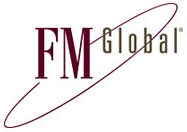Understanding Supply Chain Resilience

Resilience is at the heart of current supply chain management thinking, and understanding the concept, and where to invest in resilience, can lead to supply chains that quickly respond to and recover from costly disruptions.
When Boeing announced plans to assemble the 787 Dreamliner in late 2003, it introduced a new concept to the assembly of a commercial aircraft.
Instead of building the plane from the ground up, subcontractors from around the globe would deliver completed subassemblies to Boeing’s factory in Everett, Wash. for final assembly.
While the approach was intended to create a leaner manufacturing process, development of the new aircraft was beset by numerous supply chain related disruptions - events that interrupt the flow of products and information between raw materials, production, and the end customer.
One of those disruptions occurred just last January 2013, when the Dreamliner was grounded by the FAA due to overheating of its new lithium-ion battery.
As a result, Boeing needed to slow production of this innovative aircraft until it determined the source of the overheating - a source that appeared to lie within in its supply chain, according to news reports.
The question for Boeing was how quickly it could identify the source of the overheating and recover from the disruption.
At bottom, that was a question of how resilient the Dreamliner supply chain was. Boeing is not alone.

In today’s increasingly dynamic and turbulent world, one where the supply chain plays an increasingly more important role, numerous events occur each day that threaten to disrupt operations and jeopardize the ability to perform effectively and efficiently. These events include natural and man-made disasters such as equipment failures, fires, labor disputes, supplier defaults, political instability, and terrorist attacks.
Each can have devastating effects on a firm. Such disruptions reinforce the insights that not only can supply chain disruptions affect operations; they often result in financial damage well beyond the immediate operational impacts.
One approach to dealing with disruptions is the development of supply chain systems that are resilient. However, this notion of resilience, which is at the heart of so much of our current thinking about supply chain risk and management, is often not well-defined and subject to a great deal of confusion.
While many consultants, researchers, and managers agree on the importance of supply chain resilience, there is less agreement on what it is, how it operates, and how and where to invest to mitigate risk and recover from disruptions - to shape and influence resiliency. This article draws on the expertise of the authors, prior research, anecdotes, and recent events to define and further explore this concept.
Specifically, we propose that resilience happens by design and not by accident. The resilient supply chain requires two critical capacities : the capacity for resistance and the capacity for recovery. The first, resistance, defines the supply chain’s ability to delay a disruption and reduce the impact once the disruption occurs. The second, recovery, defines the supply chain’s ability to recover from a disruption.
The remainder of the article identifies and discusses the tradeoffs between these two resilience capacities, how each responds to issues of supply chain uncertainty and risk, and investments that firms can make to enhance supply chain resilience capabilities. The conclusion: Resilience is a capability that must fit the specific needs of each firm.
Supply Chain Resilience Defined
The concept of resilience traces its roots back to the work of C.S. Holling, an ecologist who first noted the characteristics of a resilient ecological system in 1973. Since then, the notion of resilience has been applied to fields as diverse as psychology, systems thinking, disaster management, and more recently, supply chain management.
For some, resilience is a reactive capability that occurs after a disruption or shock has taken place. Others see resilience as more proactive efforts toward helping the firm prepare for a disruption. In light of these divergent observations, it is not surprising that there is confusion surrounding this key concept.
To the authors, supply chain resilience is “the ability of a supply chain to both resist disruptions and recover operational capability after disruptions occur.“ As mentioned above, viewed from this perspective, resilience consists of two critical but complementary system components: the capacity for resistance and the capacity for recovery. Let’s look more closely at those elements:
- Resistance capacity is the ability of a system to minimize the impact of a disruption by evading it entirely (avoidance) or by minimizing the time between disruption onset and the start of recovery from that disruption (containment).
- Recovery capacity is the ability of a system to return to functionality once a disruption has occurred. The process of system recovery is characterized by a (hopefully brief) stabilization phase after which a return to a steady state of performance can be pursued. The final achieved steady-state performance may or may not reacquire original performance levels, and is dependent on many disruption and competitor factors.
Exhibit 1 portrays the impact of a disruption over time, from the moment that the disruption originates somewhere in the system (at time TD) until the system has returned to some form of steady-state (TR).
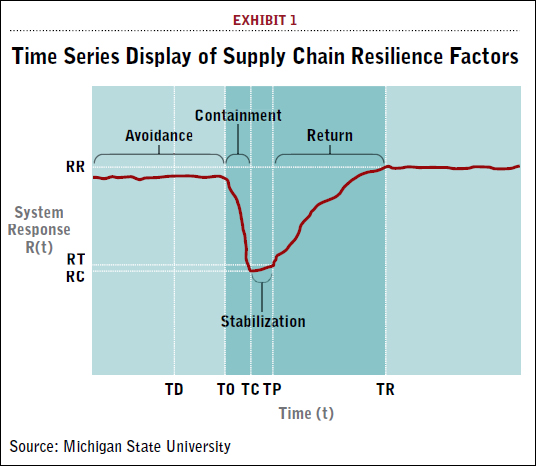
In this illustration, we can identify the four stages of resilience, which are avoidance, containment, stabilization, and return.
Exhibit 1 also defines the sequence of events, or time series signature, in a disruption as well as the typical system response for a typical disruption.
Those would include inventory levels, cash flow, and asset availability to name just a few.
Two variables are central to understanding this illustration, T and R. T denotes the time at which a specific event occurs while R denotes the relative impact of the event as measured in terms of dollars, units lost, change in fill rate, or some other metric that is important to a firm’s performance. Taken together, time (T) and response (R) are important because they define inflection points in the time series signature where a change in state can be observed.
The differences between the variance events listed in Exhibit 1 identify traits of interest to management. For example, TO-TD, or the gap between the moment at which the disruption took place (TD) and the moment that that disruption began to affect the firm (TO), tells management how long it will take for the firm’s performance to be impacted; this time interval also identifies the maximum amount of early warning that the firm can count on to begin taking action to minimize the negative effects of the disruption.
When supply chain disruptions and their traits are observed, it is interesting to compare how the policies and strategies used by the firm can affect the various events identified in Exhibit 1 and Exhibit 2 in terms of both time and impact.
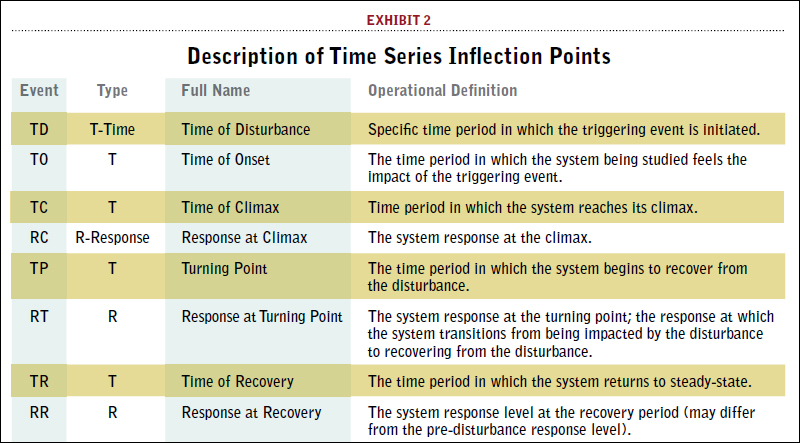
Once recovery is complete, firms often reflect upon their experience to document appropriate lessons and identify system refinements to reduce future risks. This completes a supply chain resilience cycle of: Avoidance ➝ Containment ➝ Stabilization ➝ Return ➝ Review ➝ Avoidance.
Resistance and Recovery
To illustrate the concepts of resistance and recovery, consider the 2011 Japanese earthquake and subsequent tsunami. In the wake of these twin disasters, it quickly became apparent that suppliers for both Nissan and Toyota facilities lacked adequate resistance capabilities when faced with an event of this magnitude.
Nissan, however, exhibited significant capacity for recovery. It resumed operations and regained lost market share more quickly than Toyota. Nissan was able to achieve this by accessing alternative suppliers, while Toyota stayed with existing suppliers.
Nissan’s supply chain thus provided a differential advantage over that of Toyota, despite their highly similar supply chain networks and locations relative to the earthquake/tsunami. Although full avoidance of a supply chain disruption is an admirable goal, accidents and disruptions will still occur. Instead, firms need to develop the ability to deal directly with events that are unavoidable.
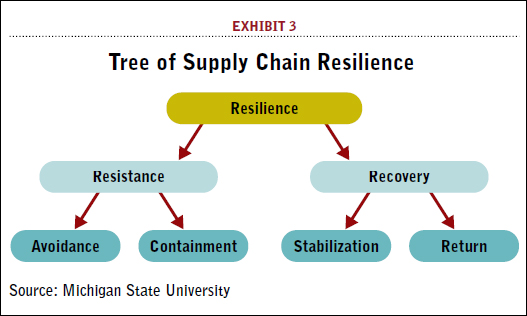
Exhibit 3 below illustrates an alternate view of supply chain resilience, which characterizes resilience into the capacities for resistance and recovery along with the respective phases: avoidance, containment, stabilization, and return.
While firms would clearly prefer to possess a high capacity for both resistance and recovery, it is more likely that firms will have a mix of these qualities.
In particular, given resource constraints and competitive factors, firms may need to choose where it is best for them to invest limited resources.
That is, the firm may not be able to afford to invest in both improving resistance and recovery.
With this in mind, the resistance and recovery matrix (Exhibit 4) characterizes possible positions that a firm might find itself in with regard to varied levels of these attributes.
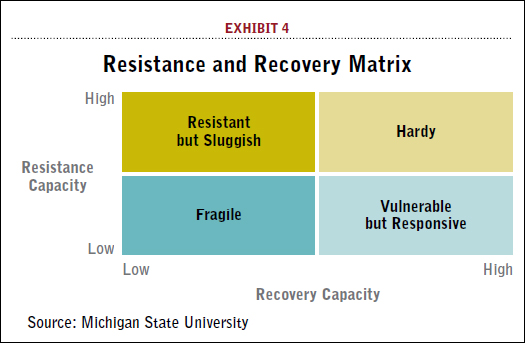
Supply chains exhibiting low capacities for both resistance and recovery would have low resistance: They would experience nearly every disruption while also having slow and weak recoveries as a result of a lack of ability to recover effectively. These supply chains are “fragile.”
Their long-term prognosis is very poor since they likely will not last and won’t grow, unless protected by unique market or regulatory conditions. For example, some industries in Sri Lanka over the past decade have suffered multiple disruptions due to civil war, theft, power outages, monsoon rains, and flooding.
Firms in these industries have survived, however, because effective competition does not exist or because competition chooses not to compete in such market or regulatory environments. As a result, fragile supply chains that provide poor quality customer service persist because the customer base is conditioned to accept low customer service.
In contrast to fragile supply chains with low resistance, those that exhibit high levels of resistance are able to alleviate potential risks more easily. When they also possess the capacity for effective recovery, they quickly rebound from those events that are unavoidable. Such supply chains are classified as “hardy.”
General Motors (GM) is an example of a hardy supply chain. According to reports, GM constantly monitors its supply chain to minimize disruptions and, when necessary, to facilitate recovery. That was the case during the Thailand floods of 2011.
Despite having plants and suppliers in the area, GM experienced limited disruptions to the flow of materials because it was able to resist the onset of problems better than its competitors. When disruptions became unavoidable, GM was robust enough to quickly work through them and recover.
Somewhere between fragile and hardy there exists two middle positions. Supply chains that are characterized by an ability to adequately minimize disruptions, but an insufficient ability to quickly recover, are ”resistant but sluggish.”
These supply chains exhibit high levels of resistance, but if the system is ultimately disrupted, the supply chain impacts are negative. These supply chains are like a heavyweight boxer who is able to take significant attacks, but who is knocked down for a significant amount of time if pushed too far.
The use of the term “sluggish” in this case does not imply ineptitude or lack of desire to restore operation, but rather insufficient capability to do so. This may arise, for example, from lack of recovery training as resources are focused toward resistance instead. The chemical industry is a case in point.
Although these firms develop relatively strong defenses against a disruption, if a spill or other event occurs it may lead to serious consequences that built-in recovery capabilities might not be sufficient to address quickly due to the nature of such spills.
The other middle position is characterized by supply chains that exhibit low resistance to disruptive events, but quickly overcome their impact. These supply chains are termed “vulnerable but responsive.” Similar to an electrical fuse in a building, these are easily knocked offline, but they have the capacity to quickly recover.
An example of such a supply chain might be that of the clothing manufacturer/retailer Zara.
Related: Zara’s Fashion Retail Supply Chain Strategies

The fashion industry is routinely beset by both supply and demand disruptions, but Zara (as well as some other manufacturers) has invested heavily in flexible manufacturing so that it can respond quickly to such changes.
Recognizing that these demand disruptions are the nature of its market, Zara has invested in responsive systems to facilitate recovery.
While the “fragile” position is clearly undesirable and the “hardy” position the brass ring, the existence of the “middle” positions requires acknowledgement that firms may reside there for two reasons.
- First, there may be limited resources with which to invest in both capabilities.
- Second, there may be limited control over the environment in which a supply chain operates.
The different manifestations of this lack of control in a supply chain require firms to consider the notions of supply chain resilience, risk, and uncertainty.
Supply Chain Resilience, Risk, and Uncertainty
The distinctions between supply chain resilience, risk, and uncertainty are often blurred and unclear. Unfortunately this issue is exacerbated by the fact that some use risk and uncertainty interchangeably, implying that these two concepts are the same. Yet, this is not the case. While linked, they are separate and distinct concepts.
Risk exists so firms have to deal with the possibilities of encountering situations that can adversely affect them. However, not all future events are equally unknown. Past experience offers some insight regarding what events could occur, the probability of occurrence, and the impact.
Firms can predict the likelihood of these events over a set time period to help them determine how to potentially react when they occur. Events with a greater likelihood and significant potential impact require greater preparation.
In contrast, uncertainty considers unpredictable events. Typically, these are events that have not been previously encountered. Alternatively, they are events where the type of event falls outside of past experience. To understand the differences, consider what happened at the Fukushima Daiichi nuclear plant following the Tohoku earthquake and tsunami.
This represented the largest nuclear disaster since the meltdown of the reactor in Chernobyl in 1986. It caused the evacuation of 100,000 people from their homes. When 11 of Japan’s 50 nuclear reactors closed immediately following the earthquake, the capacity to produce electricity was reduced by some 40 percent.
In addition, key air and seaports shut down, affecting the global supply of semiconductor equipment and materials for consumer electronics, as well as parts sourced in Japan for the wings, landing gear, and other major systems for Boeing’s 787 Dreamliner.
Yet, in studying the events that took place at Fukushima, one can see the interplay of risk and uncertainty. When the plant was first built in the 1960s, the expected maximum height of a tsunami was 5 meters (16.4 feet); the seawall built at the plant to resist this potential risk event was 5.7 meters (19 feet).
The tsunami-generated wave that hit the plant was 13 to 15 meters (43 to 49 feet) in height. This event reflects the uncertainty that is always present. While plans were made to resist a tsunami wave, the planners did not foresee such a large tsunami hitting the plant.
You could argue that what Fukushima Daiichi needed was a system that was ideally hardy but at a minimum was vulnerable but responsive. Instead, what they had was a system that was resistant but sluggish. The notion of a resistant but sluggish supply chain and a vulnerable but responsive supply chain may also be considered in this context of supply chain risk and supply chain uncertainty.
Under conditions of uncertainty, such as in the fashion industry, the best approach to building resilience may be to invest in the capacity to recover from an unpredictable disruption. On the other hand, faced with the known risk of a chemical spill, the chemical industry’s policy of avoiding such disruptions is more appropriate, especially given the extent of the damage that would otherwise result.
By differentiating between risk and uncertainty, we can uncover an important rule of thumb for resilience: When faced primarily by risk, it makes sense to invest in improving resistance; when dealing with uncertainty, it is more appropriate to invest in improving recovery capabilities.
Investing in Supply Chain Resilience
Resilience can be more properly regarded as a derived system property. That is, it is the result of the investments a firm makes over time, not a ‘free’ benefit of existence. Moreover, it can be generated through many different types of investments. These are summarized in Exhibit 5.
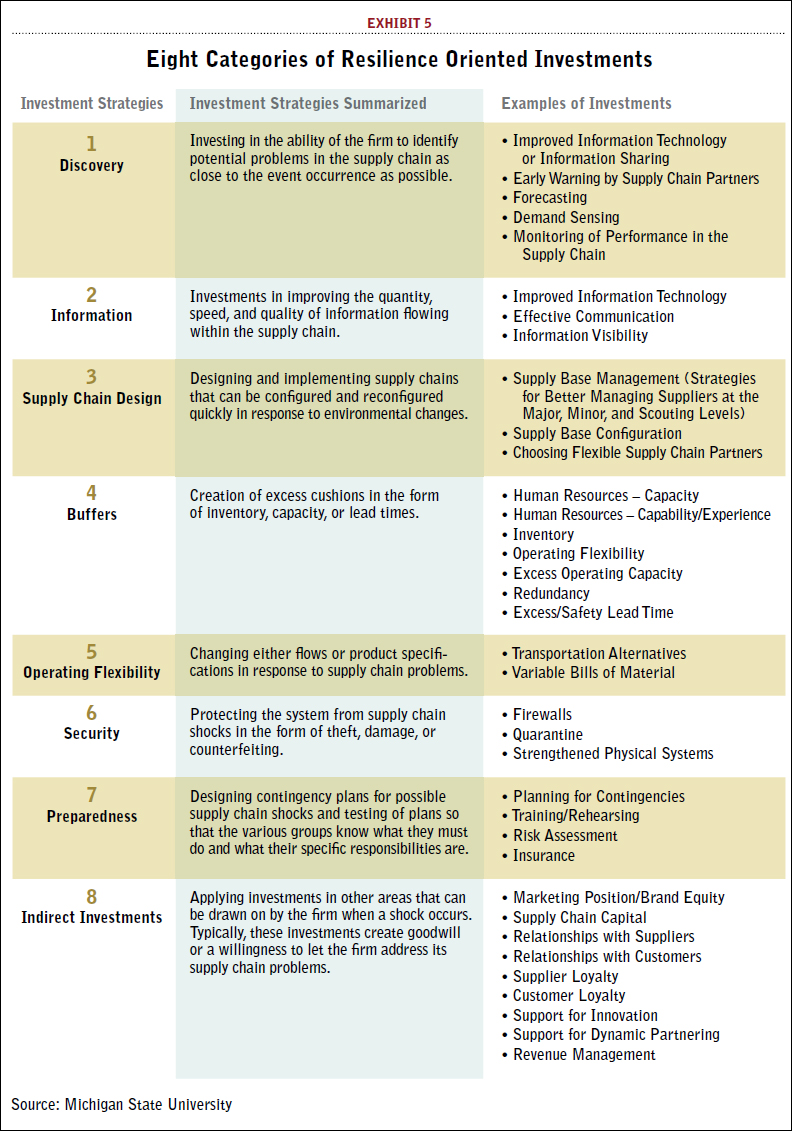
Some of these investments, such as inventory and capacity buffers, are direct investments. Investments in safety stock or increased lead-times buffer the system much like the shock absorbers on an automobile smooth a bumpy road.
Indirect investments in areas such as brand equity and customer loyalty can also have an impact on resilience. While these investments are not focused directly on enhancing the resilience of supply chain systems, they offer capabilities that the firm can draw on to deal with unexpected breakdowns in its systems.
As detailed in the sidebar below, indirect investments in brand equity and relationships with customers enabled Proctor & Gamble to recover from production problems when it introduced its Tide Pods product.
Furthermore, these investments can be mapped to specific stages within the four phases of resilience. The challenge for the firm is that of determining the choices between concern for supply chain risk or uncertainty and determining which quadrant (as illustrated in Exhibit 4) is both most appropriate and as representing the best value for the firm’s investment investments.
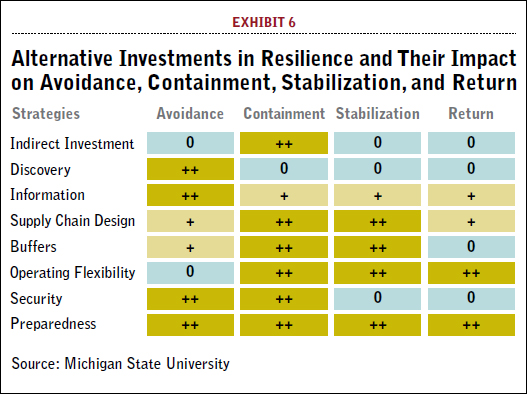
Exhibit 6 illustrates that many of these investments affect multiple stages of resilience.
Note that these investment values are qualitative approximations of value; other values may be realized in various types of supply chain situations.
In reviewing this exhibit, also note that the strength of the impact is indicated by the greenness of the shading - a moderate impact is denoted by + and yellow shading; a strong impact is denoted by ++ and green shading.
This exhibit provides example categories that can be mapped to the four phases of resilience.
It also suggests how resilience investments affect the four phases of resilience in differing ways.
What it does not convey is the nature of the impact - whether it is through main effects (where an investment such as supply chain design affects directly resilience) or through interactions (the interaction between two or more factors found in the table).
No More Happy Accidents
While there is a great deal of confusion about supply chain resilience, it really comes down to two separate but interrelated elements: resistance and recovery. Further, where your firm chooses to invest in building resilience is really a function of whether you are faced by uncertainty (in which case you invest in recovery) or risk (which justifies the investment in resistance).
Managers can make those investments in supply chain resilience through multiple venues in ways that are both appropriate to the risks a firm wants to mitigate and that make sense to the parties involved. The result is that resilience is now becoming a supply chain property that supply chain managers can shape and influence. That happens by design and is no longer a happy accident.
P&G’s Investment in Resiliency

In August 2011, Proctor & Gamble announced the introduction of the Tide Pod.
This was an innovative detergent delivery system combining a detergent, stain remover, and brightener into one easy-to-use pod.
The product was intended to increase demand in what had become a mature market.
Unfortunately, P&G had to delay the actual market entry date until early 2012 due to production challenges that limited how much product would be available at retail outlets to support a broad product launch.
The breakdown gave P&G’s competitors in the home laundry market segment an advanced warning of P&G’s intent and a chance to seize market share in the more profitable one-dose, convenience market segment.
Still, P&G was able to correct the original supply chain problems and recover from these disruptions. By December 2012, P&G was projecting first year retail sales totaling $500 million for the pods.
Given that most new products are considered a success if they achieve $50 million in sales, this turnaround is significant. Moreover, because of production constrained product scarcity, P&G has offered no promotions or discounts on the sales of this premium-priced product.
One reason for P&G’s ultimate success, despite their supply chain challenges, can be found in the indirect investments that P&G has made in brand equity and customer loyalty.
In other words, Tide brand loyal customers trusted the Tide brand, and despite market entry by competitors’ all-in-one detergent products, P&G’s customers were willing to wait until P&G resolved their supply chain problems and brought their product to market.
About the Authors
Steven A. Melnyk is a professor of Operations and Supply Chain Management in the Department of Supply Chain Management, Michigan State University. He can be reached at [email protected].
David J. Closs is the John H. McConnell Chaired Professor of Business Administration in the Department of Supply Chain Management at Michigan State. He can be reached at [email protected].
Stanley E. Griffis is an Associate Professor in the Department of Supply Chain Management at Michigan State University. He can be reached at [email protected].
Christopher W. Zobel is the R.B. Pamplin Professor of Business Information Technology at Virginia Tech. He can be reached at [email protected].
John R. Macdonald is Assistant Professor of Supply Chain Management at Michigan State University. He can be reached at [email protected].
Related: Countries That Have the Most Resilient Supply Chains

Article Topics
FM Global News & Resources
2017 Resilience Index Annual Report How Does Your Supply Chain Resilience Rank? Understanding Supply Chain Resilience The 2015 FM Global Resilience Index Annual Report Countries That Have the Most Resilient Supply ChainsLatest in Supply Chain
Apple Accused of Multiple Human Rights Violations UPS Struggles in First Quarter With Steep Earnings Decline How Supply Chains Are Solving Severe Workplace Shortages SAP Unveils New AI-Driven Supply Chain Innovations How Much Extra Will Consumers Pay for Sustainable Packaging? FedEx Announces Plans to Shut Down Four Facilities U.S. Manufacturing is Growing but Employment Not Keeping Pace More Supply Chain


